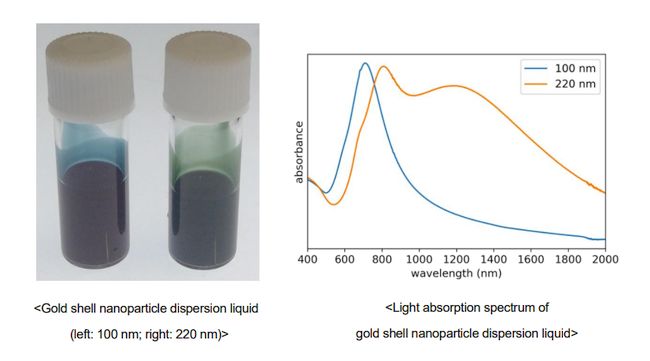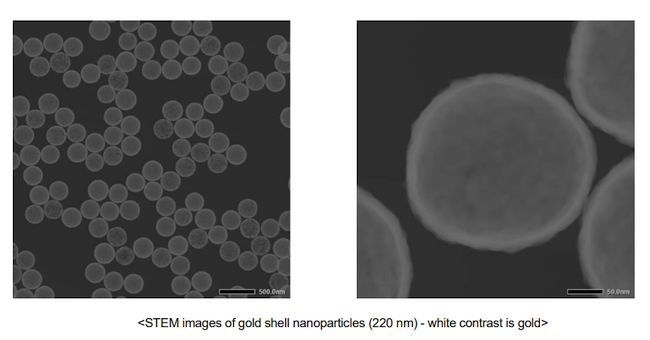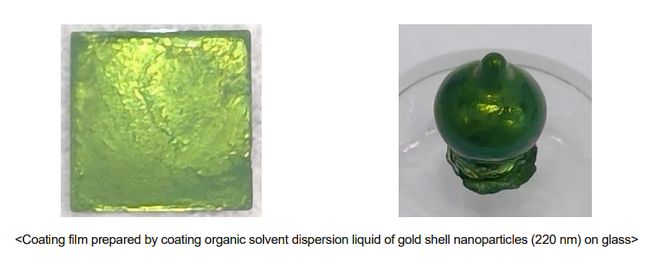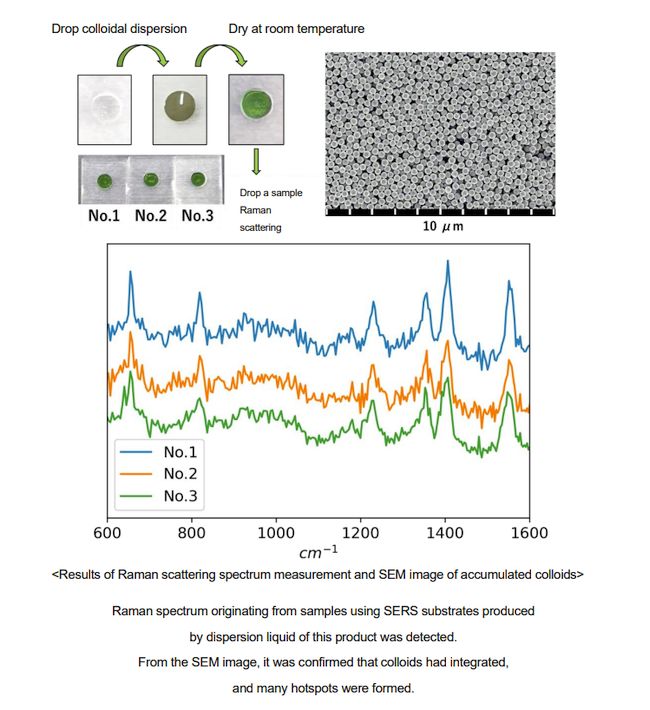
TANAKA Develops Gold Shell Nanoparticles That Can Be Prepared in High Concentrations Using High Dispersion Stability

Achieving dispersion liquids with high concentrations that are 100 to 1,000 times that of existing products with expected applications in optical devices such as optical displays, optical sensing, and biosensors
TOKYO, Mar 28, 2022 - (ACN Newswire) - TANAKA Kikinzoku Kogyo K.K. (Head office: Chiyoda-ku, Tokyo; Representative Director & CEO: Koichiro Tanaka), which operates the TANAKA Precious Metals manufacturing business, announced that TANAKA has developed gold shell nanoparticles1 that can be prepared in high concentrations using high dispersion stability.
This product is designed to cover the particle surface—such as that of silica—with an extremely thin gold shell that has a thickness of approximately 10 nm. It exhibits strong surface plasmon resonance2. Additionally, by using the high dispersion stability in water and polar solvents, it is possible to prepare dispersion liquids with high concentrations that are 100 to 1,000 times that of gold nanoparticles currently being sold on the market.
The overall size of gold shell nanoparticles can be controlled within a range of 80 nm to 250 nm, allowing them to be given a wide variety of optical characteristics. This is especially true for colloids with particle diameters several hundred nm prepared in high concentrations. They are easier to integrate or structure three-dimensionally, such as into colloid crystals, and can be expected to be applied to various optical materials.

Features of this product
■ Gold nanoshell with a thickness of 10 nm
The surface plasmon resonance exhibited by gold shell nanoparticles becomes more efficient in absorbing incident light, the thinner the shell. Compared to existing products on the market, this product achieves an extremely thin shell thickness of less than 10 nm. This allows the energy of incident light to be absorbed efficiently and also contributes toward dispersion stability as the relative mass of the overall particles becomes lighter.

■ Stable dispersion in water and organic solvents
Normally, gold nanoparticles with diameters of several hundred nm tend to autoagglutinate and precipitate as the particle concentration increases. This product can be dispersed stably in water and polar organic solvents, such as alcohol, as the particle surface is appropriately protected by a protective agent. Particles protected by the protective agent can be prepared with a weight ratio of 20% or higher, allowing use in processes that require highly-concentrated particle dispersion liquids. In addition, gold nanoshell dispersion liquids dispersed in organic solvents have excellent quick-drying properties and can also be coated on materials of various shapes.

■ Can produce SERS substrate by simply drying highly-concentrated gold nanoshell dispersion liquid
Surface-enhanced Raman scattering (SERS)3 exhibited by precious metal nanoparticles is particularly strong at the gaps between particles when precious metal nanoparticles are integrated. The locations where SERS is strongly manifested are called hotspots; being able to form hotspots with good reproducibility is important when producing SERS substrate. Traditionally, precious metal substrates with minute irregularities on the surface are used, but there were issues, such as low reproducibility.
This time, TANAKA Kikinzoku Kogyo has designed gold shell nanoparticles with surface plasmon resonance close to the wavelength of SERS excitation light, confirming that it is possible to produce SERS substrates with dense hotspots by simply drying highly-concentrated dispersion liquids.

Due to the aforementioned characteristics, this product can be expected to be used as an optical material that responds to light from visible to near-infrared regions, including colloid crystals, surface-enhanced Raman scattering, and photothermal conversion materials. Applications to optical devices are also expected, including optical displays and optical sensing that require high resolutions using liquid crystals, plasmonic nanoantennas, and biosensors, such as those used in cancer tests.
TANAKA Kikinzoku Kogyo plans to sequentially respond individually to requests for samples of this product.
----------------------------------------------------------------------------------------------------
1 Gold shell nanoparticle: This is a particle that forms a gold shell with a thickness in the order of nanometers on the surface of a core particle, which can be a colloid of inorganic materials, metals, or polymers. Various optical responses, different from pure gold nanoparticles, are exhibited depending on the shell thickness, core size, and core material.
2 Surface plasmon resonance: This is a phenomenon where the vibrations of free electrons in metals on the surface of metal nanoparticles resonate with incident light. The brilliant colors shown by gold shell nanoparticles are due to this phenomenon.
3 Surface-enhanced Raman scattering (SERS): When light is shone on a material, a wavelength different from the incident light is scattered by the material. This scattered light with a wavelength different from the incident light is called Raman scattered light, and every material exhibits its own unique Raman scattering spectrum. Therefore, it is possible to obtain information about the types of materials present by measuring the Raman scattering spectrum. However, to detect minute amounts of materials, it is necessary to enhance the Raman scattered light.
Surface-enhanced Raman scattering (SERS) is a phenomenon where the intensity of Raman scattered light is amplified when materials are absorbed at locations such as irregularities on surfaces of precious metals and in the gaps of precious metal colloids. As it is possible to detect even fewer molecules by designing precious metal surfaces that are suitable for enhancing Raman scattering, applications in fields such as drug detection and cancer diagnosis can be expected.
■ About TANAKA Precious Metals
Since its foundation in 1885, TANAKA Precious Metals has built a portfolio of products to support a diversified range of business uses focused on precious metals. TANAKA is a leader in Japan regarding the volumes of precious metals handled. Over the course of many years, TANAKA has not only manufactured and sold precious metal products for industry but also provided precious metals in such forms as jewelry and assets. As precious metals specialists, all Group companies in Japan and around the world collaborate and cooperate on manufacturing, sales, and technology development to offer a range of products and services. With 5,193 employees, the group's consolidated net sales for the fiscal year ending March 31, 2021, was 1,425.6 billion yen. https://www.tanaka.co.jp/english/.
■ Global industrial business website
https://tanaka-preciousmetals.com
■ Product inquiries
TANAKA Kikinzoku Kogyo K.K.
https://tanaka-preciousmetals.com/en/inquiries-on-industrial-products/
■ Press inquiries
TANAKA Holdings Co., Ltd.
https://tanaka-preciousmetals.com/en/inquiries-for-media/
Editor Details
-
Company:
- ACN Newswire
-
Name:
- Marie Bergado
- Email:
-
Telephone:
- +6328470809
- Website:
